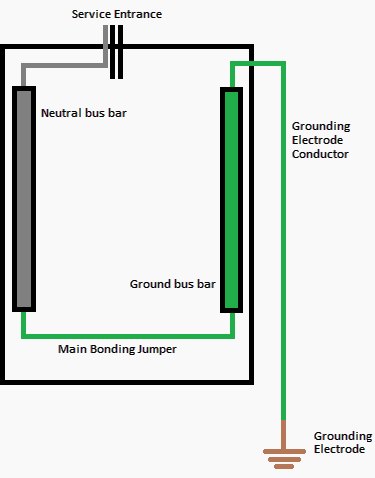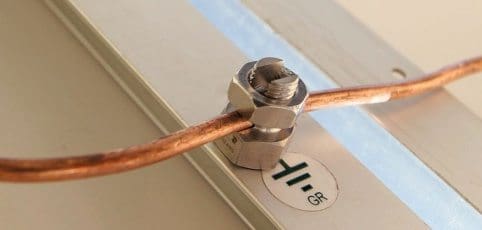
18 Key Terms Defined In NEC System Grounding Requirements (on photo: Rack Ground Bus bar – RGB located within a cabinet or rack is properly bonded back to the Master Ground Bus bar – MGB; via r56audits.com)
System Grounding Arrangement
The topic of system grounding is extremely important, as it affects the susceptibility of the system to voltage transients, determines the types of loads the system can accommodate, and helps to determine the system protection requirements.
The system grounding arrangement is determined by the grounding of the power source. For commercial and industrial systems, the types of power sources generally fall into four broad categories:
- Utility Service – The system grounding is usually determined by the secondary winding configuration of the upstream utility substation transformer.
- Generator – The system grounding is determined by the stator winding configuration.
- Transformer – The system grounding on the system fed by the transformer is determined by the transformer secondary winding configuration.
- Static Power Converter – For devices such as rectifiers and inverters, the system grounding is determined by the grounding of the output stage of the converter.
As a starting point, 18 key terms from the NEC need to be defined:
1. Ground
A conducting connection, whether intentional or accidental, between an electrical circuit or equipment and the earth or to some body that serves in place of the earth.

Ground definition (photo credit: ibiblio.org)
2. Grounded
Connected to earth or to some body that serves in place of the earth.
3. Effectively Grounded
Intentionally connected to earth through a ground connection or connections of sufficiently low impedance and having sufficient current-carrying capacity to prevent the buildup of voltages that may result in undue hazards to connected equipment or to persons.
4. Grounded Conductor
A system or circuit conductor that is intentionally grounded.

Grounding simple scheme (photo credit: diy.stackexchange.com)
5. Solidly Grounded
Connected to ground without inserting any resistor or impedance device.
6. Grounding Conductor
A conductor used to connect equipment or the grounded circuit of a wiring system to a grounding electrode or electrodes.
7. Equipment Grounding Conductor
The conductor used to connect the non-current-carrying metal parts of equipment, raceways and other enclosures to the system grounded conductor, grounding electrode conductor, or both, at the service equipment or at the source of a separately-derived system.

Equipment grounding conductor
8. Main Bonding Jumper
The connection between the grounded circuit conductor and the equipment grounding conductor at the service.

Service equipment enclosures are connected to the neutral by a main bonding jumper (photo credit: jade1.com)
9. System Bonding Jumper
The connection between the grounded circuit conductor and the equipment grounding conductor at a separately-derived system.
10. Grounding Electrode
The conductor used to connect the grounding electrode(s) to the equipment grounding conductor, to the grounded conductor, or to both, at the service, at each building or structure where supplied by a feeder(s) or branch circuit(s), or at the source of a separately-derived system.
11. Grounding Electrode Conductor
The conductor used to connect the grounding electrode(s) to the equipment grounding conductor, to the grounded conductor, or to both, at the service, at each building or structure where supplied by a feeder(s) or branch circuit(s), or at the source of a separately-derived system.

Earthing electrode
12. Ground Fault
An unintentional, electrically conducting connection between an ungrounded conductor of an electrical circuit and the normally non-current-carrying conductors, metallic enclosures, metallic raceways, metallic equipment, or earth.
13. Ground Fault Current Path
An electrically conductive path from the point of a ground fault on a wiring system through normally non–current-carrying conductors, equipment, or the earth to the electrical supply source.
14. Effective Ground-Fault Current Path
An intentionally constructed, permanent, low-impedance electrically conductive path designed and intended to carry current under ground-fault conditions from the point of a ground fault on a wiring system to the electrical supply source and that facilitates the operation of the overcurrent protective device or ground fault detectors on high-impedance grounded systems.
15. Ground-Fault Circuit Interrupter

GFCI – Ground fault circuit interrupter (photo credit: education.nachi.org)
A device intended for the protection of personnel that functions to de-energize a circuit or portion thereof within an established period of time when a current to ground exceeds the values established for a Class A device.
16. FPN
Class A ground-fault circuit interrupters trip when the current to ground has a value in the range of 4 mA to 6 mA. More information can be found on UL 943, Standard for Ground-Fault Circuit Interrupters.
17. Ground Fault Protection of Equipment
A system intended to provide protection of equipment from damaging line-to-ground fault currents by operating to cause a disconnecting means to open all ungrounded conductors of the faulted circuit.
18. Qualified Person
One who has the skills and knowledge related to the construction and operation of the electrical equipment and installations and has received safety training on the hazards involved.
With these terms defined, several of the major components of the grounding system can be illustrated by Figure 1 and labeling the components.

Figure 1 – NEC system grounding terms illustration
Reference: System Grounding – Bill Brown, P.E., Square D Engineering Services